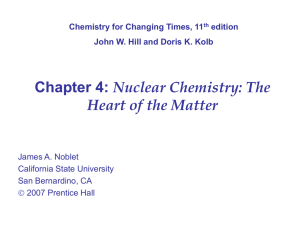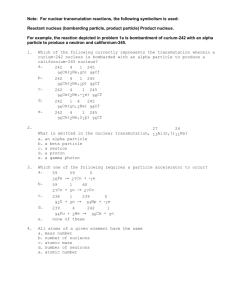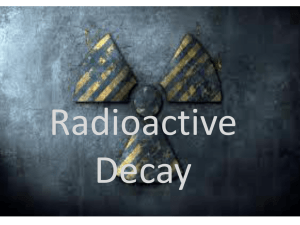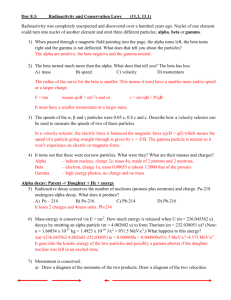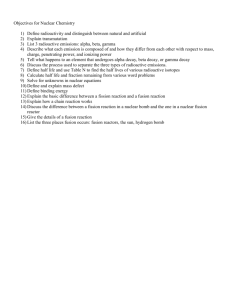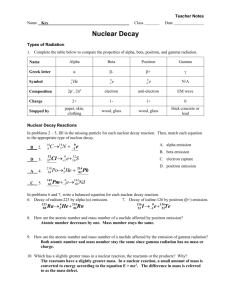CW Types of Nuclear Decay 011708 051709
advertisement
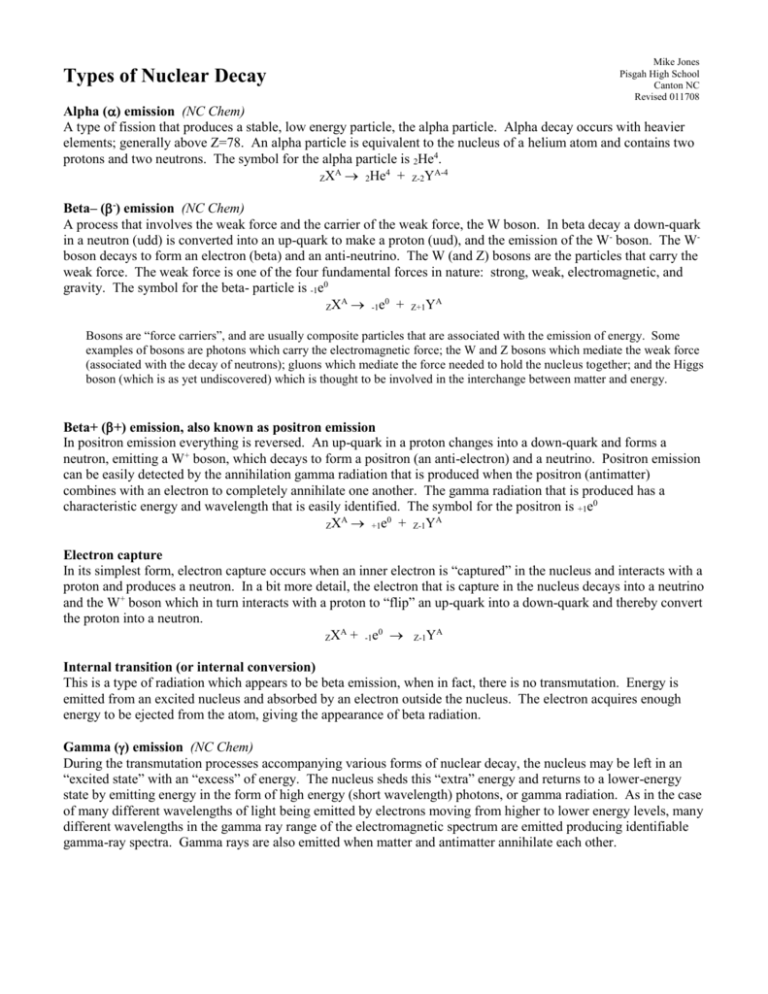
Types of Nuclear Decay Mike Jones Pisgah High School Canton NC Revised 011708 Alpha () emission (NC Chem) A type of fission that produces a stable, low energy particle, the alpha particle. Alpha decay occurs with heavier elements; generally above Z=78. An alpha particle is equivalent to the nucleus of a helium atom and contains two protons and two neutrons. The symbol for the alpha particle is 2He4. A 4 A-4 ZX 2He + Z-2Y Beta– ( -) emission (NC Chem) A process that involves the weak force and the carrier of the weak force, the W boson. In beta decay a down-quark in a neutron (udd) is converted into an up-quark to make a proton (uud), and the emission of the W- boson. The Wboson decays to form an electron (beta) and an anti-neutrino. The W (and Z) bosons are the particles that carry the weak force. The weak force is one of the four fundamental forces in nature: strong, weak, electromagnetic, and gravity. The symbol for the beta- particle is -1e0 A 0 A ZX -1e + Z+1Y Bosons are “force carriers”, and are usually composite particles that are associated with the emission of energy. Some examples of bosons are photons which carry the electromagnetic force; the W and Z bosons which mediate the weak force (associated with the decay of neutrons); gluons which mediate the force needed to hold the nucleus together; and the Higgs boson (which is as yet undiscovered) which is thought to be involved in the interchange between matter and energy. Beta+ (+) emission, also known as positron emission In positron emission everything is reversed. An up-quark in a proton changes into a down-quark and forms a neutron, emitting a W+ boson, which decays to form a positron (an anti-electron) and a neutrino. Positron emission can be easily detected by the annihilation gamma radiation that is produced when the positron (antimatter) combines with an electron to completely annihilate one another. The gamma radiation that is produced has a characteristic energy and wavelength that is easily identified. The symbol for the positron is +1e0 A 0 A ZX +1e + Z-1Y Electron capture In its simplest form, electron capture occurs when an inner electron is “captured” in the nucleus and interacts with a proton and produces a neutron. In a bit more detail, the electron that is capture in the nucleus decays into a neutrino and the W+ boson which in turn interacts with a proton to “flip” an up-quark into a down-quark and thereby convert the proton into a neutron. A 0 A ZX + -1e Z-1Y Internal transition (or internal conversion) This is a type of radiation which appears to be beta emission, when in fact, there is no transmutation. Energy is emitted from an excited nucleus and absorbed by an electron outside the nucleus. The electron acquires enough energy to be ejected from the atom, giving the appearance of beta radiation. Gamma () emission (NC Chem) During the transmutation processes accompanying various forms of nuclear decay, the nucleus may be left in an “excited state” with an “excess” of energy. The nucleus sheds this “extra” energy and returns to a lower-energy state by emitting energy in the form of high energy (short wavelength) photons, or gamma radiation. As in the case of many different wavelengths of light being emitted by electrons moving from higher to lower energy levels, many different wavelengths in the gamma ray range of the electromagnetic spectrum are emitted producing identifiable gamma-ray spectra. Gamma rays are also emitted when matter and antimatter annihilate each other. Chemistry Worksheet Date _______________________ Period __ Name ________________________________ Types of Nuclear Decay Alpha () emission A type of fission that produces a stable, low energy particle, the alpha particle. Alpha decay occurs with heavier elements; generally above Z=78. An alpha particle is equivalent to the nucleus of a helium atom and contains two protons and two neutrons. The symbol for the alpha particle is 2He4. Alpha emission is sometimes referred to as a form of nuclear fission, where the atom splits into a decay product and an alpha particle. ZX Example of alpha decay: Th 232 90 228 88 A 2He4 + Z-2Y A-4 Ra 24 He Beta– ( -) emission A process that involves the weak force and the carrier of the weak force, the W boson. In beta decay a down-quark in a neutron (udd) is converted into an up-quark to make a proton (uud), and the emission of the W- boson. The Wboson decays to form an electron (beta) and an anti-neutrino. The W (and Z) bosons are the particles that carry the weak force. The weak force is one of the four fundamental forces in nature: strong, weak, electromagnetic, and gravity. The symbol for the beta- particle is -1e0. ZX Example of alpha decay: 146 C 147 N A -1e 0 + Z+1Y A 0 1 e Gamma () emission During the transmutation processes accompanying various forms of nuclear decay, the nucleus may be left in an “excited state” with an “excess” of energy. The nucleus sheds this “extra” energy and returns to a lower-energy state by emitting energy in the form of high energy (short wavelength) photons, or gamma radiation. As in the case of many different wavelengths of light being emitted by electrons moving from higher to lower energy levels, many different wavelengths in the gamma ray range of the electromagnetic spectrum are emitted producing identifiable gamma-ray spectra. Gamma rays are also emitted when matter and antimatter annihilate each other. Example of gamma decay: 137 56 Ba* 137 56 Ba Fission The splitting of the nucleus of an unstable atom into two smaller atoms is “fission”. Only certain heavy elements can undergo fission. Some atoms undergo spontaneous fission, where the unstable atom simple splits apart. Most fission reactions occur when the nucleus absorbs a slow-moving neutron, making it unstable, and then it splits. Example of a spontaneous fission reaction: 92 1 1 1 U 141 56 Ba 36 Kr 0 n 0 n 0 n 236 92 Fusion The combining of two simple atoms to make a more complex atom. The process is carried out in stars as new, heavier elements are made during the lifetime of the star. Example of a fusion reaction: 3 1 H 12 H 24 He 01n Nuclear Chemistry Worksheet 1. Germanium-75 decays by beta emission. Determine the decay product. a. As-74 b. As-75 c. Ga-75 d. Zn-71 e. Zn-75 2. An alpha particle is emitted when Th-223 decays. What is the decay product? a. Pa-219 b. Pa-223 c. Ra-219 d. Ra-223 e. Rn-221 3. Which is a correctly written decay equation? a. 94Po210 92U210 + 2He0 b. 53I128 4He2 + 49In126 c. 13Al28 14Si28 + -1e0 d. 35Br80 0e-1 + 35Br81 e. 94Pu245 40Zr92 + 54Xe132 4. After 6 seconds, the mass of a sample of radioactive material has decreased from 100 grams to 25 grams. Its half-life must be a. 1 s b. 2 s c. 3 s d. 4 s e. 6 s 5. Which best describes this reaction? 92U235 + 0n1 54Xe138 + 38Sr96 + 20n1 a. This is a fission reaction equation b. This is a fusion reaction equation c. This is an alpha decay equation d. This is a beta decay equation e. This is a gamma decay equation 6. For any radioactive material, how is its half-life described? a. It first decreases and then increases. b. It first increases and then decreases. c. It increases with time. d. It decreases with time. e. It stays the same. 7. If the half-life of a substance is 5 seconds, when will it cease to be radioactive (i.e. it ceases emitting particles)? a. After 5 seconds. b. After 40 seconds. c. After 20 days. d. After 3 months. e. After a very long time. 8. You detect a high number of alpha particles every second when standing a certain distance from a radioactive material. If you triple your distance from the source, the number of alpha particles you detect will decrease. By what factor will it decrease? a. 3 b. 3 c. 9 d. 27 e. It will stay the same. The following questions are NOT multiple choice. Do each part. 9. You have 5 grams of radioactive substance A and 5 grams of radioactive substance B. Both decay by emitting alpha-radiation, and you know that the higher the number of alpha-particles emitted in a given amount of time, the more dangerous the sample is. Substance A has a short half-life (around 4 days or so) and substance B has a longer half-life (around 10 months or so). a. Which substance is more dangerous right now? Explain. b. Which substance will be more dangerous in two years? Explain. 10. Write the nuclear equations (A B + C) for the following reactions. a. The alpha decay of 88Ra219 b. The beta decay of 63Eu158 c. The beta decay of 22Ti53 d. The alpha decay of 83Bi211 11. A certain radioactive material has a half-life of 8 minutes. Suppose you have a large sample of this material, containing 4.0x1025 atoms. a. How many atoms decay in the first 8 minutes? b. Does this strike you as a dangerous release of radiation? Explain. c. How many atoms decay in the second 8 minutes? d. What is the ratio of the number of atoms that decay in the first 8 minutes to the number of atoms that decay in the second 8 minutes? 12. An evil scientist has hidden in his secret laboratory 100 grams each of two radioactive substances, which we shall simply call A and B. Both emit alpha-radiation. Substance A has a half-life of 10 days and substance B has a half-life of 300 days. How many grams of substance A will there be after 30 days? How will this compare to the amount of B that remains after 30 days? Which sample (A or B) is more dangerous after 30 days have passed? Be sure to explain your answers. 13. What is a “nuclear chain reaction”? What is “critical mass”? 14. What is the purpose of controls rods in a nuclear reactor? What is the purpose of a moderator in a nuclear reactor? 15. At a nuclear power station, what is found in the containment building?


